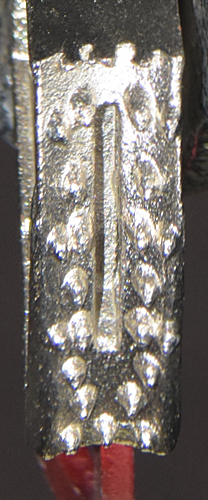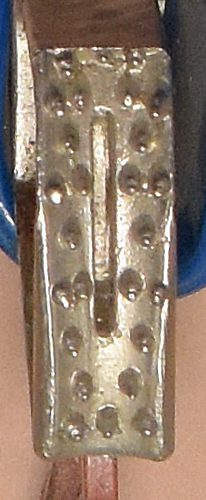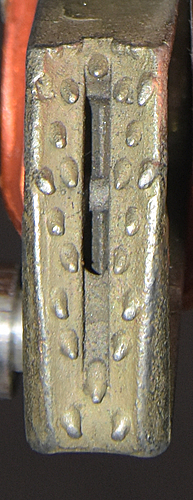Overview
[ Top
| Version B
| Version C
| Return to E.C. Ascenders
]
 Version A
Version A
(#2933)
Technical Details
I acquired my Al’turs (Альтурс), Version A from Artyom Babin (Артём Бабин) in 2019.
The Al’turs (Альтурс), Version A is 115 mm. tall, 79 mm. wide, 38 mm. thick, and weighs 152 g.
 The ascender shell is an irregular
shape bent from 4 mm. aluminum sheet. The
rope channel is formed by bending the right side of the ascender
into a U. The rope channel is 16 mm. wide. The main sling attachment point is located below the cam and behind the
rope channel. A second attachment point is located above the cam,
also behind the rope channel. The shell is bent backwards at both
points to provide clearance between the attachment slings and
the main rope. This accounts for the rather large thickness of
this ascender. The attachment points appear to be ovals distorted
by the stamping operation. The lower attachment point measures
22.4 by 17.7 mm. and the upper 16.4 by 12.3 mm. The left side
of the shell is bent on an inclined axis to form another U. A
hole drilled through both sides of the U accepts a semi-tubular rivet.
The cam and cam spring are mounted on this rivet. The head of
the rivet sits on the edge of a stamped depression on the back of the cam (clearly off-center from the intent),
while the roll is exposed on the open side. The pivot is centered
47 mm. from the inside of the rope channel.
The ascender shell is an irregular
shape bent from 4 mm. aluminum sheet. The
rope channel is formed by bending the right side of the ascender
into a U. The rope channel is 16 mm. wide. The main sling attachment point is located below the cam and behind the
rope channel. A second attachment point is located above the cam,
also behind the rope channel. The shell is bent backwards at both
points to provide clearance between the attachment slings and
the main rope. This accounts for the rather large thickness of
this ascender. The attachment points appear to be ovals distorted
by the stamping operation. The lower attachment point measures
22.4 by 17.7 mm. and the upper 16.4 by 12.3 mm. The left side
of the shell is bent on an inclined axis to form another U. A
hole drilled through both sides of the U accepts a semi-tubular rivet.
The cam and cam spring are mounted on this rivet. The head of
the rivet sits on the edge of a stamped depression on the back of the cam (clearly off-center from the intent),
while the roll is exposed on the open side. The pivot is centered
47 mm. from the inside of the rope channel.
The cam is a skeletonized steel casting. The cam radius,
measured from the pivot, increases from 38 to 53 mm. over an angle of 41°, giving a 25° cam angle. The cam has number of small conical teeth that slope downwards with respect to the cam face. The tooth pattern is (3.4)(2S2.1S1)^2(2.2.3). A spring-loaded manual safety bar is mounted on the bottom of
the cam with a steel rivet. The safety has a large ring grip. The normal action
of the spring holds the safety against the cam. When the cam is
opened, the shell interferes with the safety bar, thus preventing
opening the cam. If the safety bar is moved away from the cam
(opposing the spring), it will barely clear the shell and the cam will
open. At full open the safety can be released and the spring will
hold the safety against the back of the shell. This provides a
means of locking the cam open. There is a cylindrical cam stop attached to the shell above the cam.
There are no markings on this ascender other than a printed sticker, and that sticker is partly missing. The remaining portion has a logo, "АЛЬТУРС" (transliterates as Al’turs), "ПРОИЗВОД…" (probably ПРОИЗВОДСТВО, production), "r. Нов…" (probably "Новосибирск" meaning Novosibirsk), and "тел. (33…" (probably a telephone number).
This Альтурс is roughly constructed. The cam rivet does not align with the depression provided for the rivet head. There are some tool marks from bending the shell. The cam teeth are dull and not well formed. Worst of all, the cam safety must be forced to clear the shell. This is perhaps the worst-fitting cam safety that I have ever seen, and because of this, the ascender is practically unusable. It deserves a lemon award:  .
.
The ascender shell has a mottled texture paint that helps hide some of the manufacturing marks. Unfortunately, paint just makes a mess on ropes.
[ Top
| Version A
| Version C
| Return to E.C. Ascenders
]
Version B
(#3518)
Technical Details
I acquired this Альтурс from Artyom Babin (Артём Бабин) in 2022.
 The Альтурс is left-handed.
The ascender is 113 mm. high, 79 mm. wide, 43 mm.
thick, and weighs 146 grams. The ascender shell is subtriangular
shape bent from 4 mm. aluminum sheet and painted blue. The
rope channel is formed by bending the right side of the ascender
into a U. The rope channel is 16 mm. wide. The main sling attachment point is located below the cam and behind the
rope channel. A second attachment point is located above the cam,
also behind the rope channel. The shell is bent backwards at both
points to provide clearance between the attachment slings and
the main rope. This accounts for the rather large thickness of
this ascender. The attachment points appear to be ovals distorted
by the stamping operation. The lower attachment point measures
23.2 by 17.4 mm. and the upper 20.0 by 18.5 mm. The left side
of the shell is bent on an inclined axis to form another U. A
hole drilled through both sides of the U accepts a semi-tubular rivet.
The cam and cam spring are mounted on this rivet. The head of
the rivet sits on the edge of a stamped depression on the back of the cam (clearly off-center from the intent),
while the roll is exposed on the open side. The pivot is centered 49
mm. from the inside of the rope channel.
The Альтурс is left-handed.
The ascender is 113 mm. high, 79 mm. wide, 43 mm.
thick, and weighs 146 grams. The ascender shell is subtriangular
shape bent from 4 mm. aluminum sheet and painted blue. The
rope channel is formed by bending the right side of the ascender
into a U. The rope channel is 16 mm. wide. The main sling attachment point is located below the cam and behind the
rope channel. A second attachment point is located above the cam,
also behind the rope channel. The shell is bent backwards at both
points to provide clearance between the attachment slings and
the main rope. This accounts for the rather large thickness of
this ascender. The attachment points appear to be ovals distorted
by the stamping operation. The lower attachment point measures
23.2 by 17.4 mm. and the upper 20.0 by 18.5 mm. The left side
of the shell is bent on an inclined axis to form another U. A
hole drilled through both sides of the U accepts a semi-tubular rivet.
The cam and cam spring are mounted on this rivet. The head of
the rivet sits on the edge of a stamped depression on the back of the cam (clearly off-center from the intent),
while the roll is exposed on the open side. The pivot is centered 49
mm. from the inside of the rope channel.
The cam is a skeletonized steel casting. The cam radius,
measured from the pivot, increases from 38 to 53 mm. over an angle of 41°, giving a 25° cam angle. The cam has number of small conical teeth that slope downwards with respect to the cam face. The tooth pattern is (3.4)(2S2.1S1)^2(2.2.3). A spring-loaded manual safety is mounted on the bottom of
the cam with a steel rivet. The safety has a 36 mm. D-shaped finger tab. The normal action
of the spring holds the safety against the cam. When the cam is
opened, the shell interferes with the safety bar, thus preventing
opening the cam. If the safety bar is moved away from the cam
(opposing the spring), it will clear the shell and the cam will
open. At full open the safety can be released and the spring will
hold the safety against the back of the shell. This provides a
means of locking the cam open. A knob on the safety
bar assists in operating the safety mechanism. There is a cylindrical cam stop attached to the shell above the cam.
There are no markings on this ascender other than two printed stickers on the back. The firststicker has a logo with "Альтурс" (transliterates as Al’turs), "r. Новосибирск" (Novosibirsk), and a telephone number. The second sticker has "индивидуально тестировано" (individually tested), "Основно ось 800 кг" (main axle 800 kg), "Нагрузка на кулачок 100 кг" (cal loadd 100 kg) and "испытан" (tested).
This version has better workmanship than Version A, and the remaining rough spots do not affect its operation. The top of the cam shows machining marks, but these are harmless. The cam axle rivet is misalighed with the stamped depression in the rear of the shell, and so the rivet head sits aboe the depression by about 1.5 mm. Since it hangs up on the main shell surfce, it is not loose and does not affect operation, but it could have been aligned better.
[ Top
| Version A
| Version B
| Return to E.C. Ascenders
]
Version C
(#2143)
Technical Details
I acquired this Альтурс in 2017 as part of Bob Thrun’s collection.
 The Альтурс is left-handed.
The ascender is 115 mm. high, 78 mm. wide, 40 mm.
thick, and weighs 142 grams. The ascender shell is subtriangular
shape bent from 4 mm. aluminum sheet. The
rope channel is formed by bending the right side of the ascender
into a U. The rope channel is 15 mm. wide. The main sling attachment point is located below the cam and behind the
rope channel. A second attachment point is located above the cam,
also behind the rope channel. The shell is bent backwards at both
points to provide clearance between the attachment slings and
the main rope. This accounts for the rather large thickness of
this ascender. The attachment points appear to be ovals distorted
by the stamping operation. The lower attachment point measures
22.7 by 17.1 mm. and the upper 16.5 by 12.3 mm. The left side
of the shell is bent on an inclined axis to form another U. A
hole drilled through both sides of the U accepts a semi-tubular rivet.
The cam and cam spring are mounted on this rivet. The head of
the rivet sits on the edge of a stamped depression on the back of the cam (clearly off-center from the intent),
while the roll is exposed on the open side. The pivot is centered
48 mm. from the inside of the rope channel.
The Альтурс is left-handed.
The ascender is 115 mm. high, 78 mm. wide, 40 mm.
thick, and weighs 142 grams. The ascender shell is subtriangular
shape bent from 4 mm. aluminum sheet. The
rope channel is formed by bending the right side of the ascender
into a U. The rope channel is 15 mm. wide. The main sling attachment point is located below the cam and behind the
rope channel. A second attachment point is located above the cam,
also behind the rope channel. The shell is bent backwards at both
points to provide clearance between the attachment slings and
the main rope. This accounts for the rather large thickness of
this ascender. The attachment points appear to be ovals distorted
by the stamping operation. The lower attachment point measures
22.7 by 17.1 mm. and the upper 16.5 by 12.3 mm. The left side
of the shell is bent on an inclined axis to form another U. A
hole drilled through both sides of the U accepts a semi-tubular rivet.
The cam and cam spring are mounted on this rivet. The head of
the rivet sits on the edge of a stamped depression on the back of the cam (clearly off-center from the intent),
while the roll is exposed on the open side. The pivot is centered
48 mm. from the inside of the rope channel.
The cam is a skeletonized steel casting. The cam radius,
measured from the pivot, increases from 37 to 53 mm. over an angle of 39°, giving a 28° cam angle. The cam has number of small conical teeth that slope downwards with respect to the cam face. The tooth pattern is (2.2)(2S2.1S1)^2(1S1)^3(1.2). A spring-loaded manual safety bar is mounted on the bottom of
the cam with a steel rivet. The normal action
of the spring holds the safety against the cam. When the cam is
opened, the shell interferes with the safety bar, thus preventing
opening the cam. If the safety bar is moved away from the cam
(opposing the spring), it will clear the shell and the cam will
open. At full open the safety can be released and the spring will
hold the safety against the back of the shell. This provides a
means of locking the cam open. A knob on the safety
bar assists in operating the safety mechanism. There is a cylindrical cam stop attached to the shell above the cam.
There are no markings on this ascender other than a printed sticker. The sticker has "Туристическая Фирма" (Tourist Company), a logo, "Альтурс" (transliterates as Al’turs), "630064 r. Новосибирск" (Novosibirsk), "уп. Ватутина" (the Belgorod area), along with telephone and fax numbers.
The Альтурс is rather roughly constructed, but not to the point that it interferes with operation or safety. The cam rivet does not align with the depression provided for the rivet head. There are some tool marks from bending the shell, and some holidays in the cam casting, but these are minor. All sharp edges were removed, and the cam works smoothly. The cam on mine shows traces of surface rust on the inside of the web.
[ Top
| Version A
| Version B
| Version C
]


